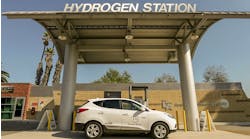As concern grows about the effect of greenhouse gas (GHG) emissions on the climate, the educational community is leading the effort to address the problem. More than 500 colleges and universities have signed the American College and University Presidents' Climate Commitment (ACUPCC), promising to reduce carbon emissions dramatically. Secondary schools are not part of the ACUPCC, but many are undertaking their own GHG emissions reduction efforts, and the ACUPCC provides a framework for reducing any campus' carbon footprint.
The ACUPCC requires signatories to “complete a comprehensive inventory of all greenhouse gas emissions (including emissions from electricity, heating, commuting and air travel) and update the inventory every other year thereafter.” Many campuses that have signed the ACUPCC have never conducted an emissions inventory or quantified their carbon footprint, and are not sure how to tackle the process.
Sifting through
The ACUPCC offers guidance, but it is not comprehensive, and it leaves many specific questions for individual campuses to answer. There is a lot of confusion about how to determine a carbon footprint, and certain key issues must be thought through in advance, or the process can be a struggle.
The six essential steps to completing a GHG emissions inventory:
-
Step 1: Establish commitment
It certainly is possible to conduct a GHG emissions inventory without buy-in from the highest levels of campus administration, but having the president or other members of the senior administration on board will make the process much easier. If a campus already has signed the ACUPCC, the dedication is there. If not, the administration may be persuaded by the number of peer institutions that have signed, or by the fact that reducing GHG emissions often means energy-use reductions and substantially lower energy costs.
It also is important to make sure that certain campus stakeholders support the effort, particularly the ones that will provide necessary data.
-
Step 2: Determine roles and responsibilities
Is there someone on campus whose job it is to do this (like a sustainability coordinator)? If not, setting up a task force can be helpful. It also is a good idea to recruit student groups to help; they bring a lot of enthusiasm, and this can be an excellent educational opportunity.
-
Step 3: Define scope
This often is the most difficult step. Deciding what emissions to include the first time can be tricky. The ACUPCC requires that signatories measure:
-
“Scope 1” or “direct” and “fugitive” emissions, which are emissions from the campus' fuel-burning equipment (including the campus fleet vehicles, and buses that burn gasoline and diesel fuel), and releases from equipment that contains refrigerants (HFCs), respectively.
-
“Scope 2” emissions, which are the emissions attributable to the electricity that the campus purchases from the local utility.
-
“Scope 3” emissions from commuting and from air travel paid for by the college (to the extent that the data are available) — in addition to air travel, this includes emissions from athletic travel; commuting to and from campus by faculty, staff and students; and business travel by campus employees. The ACUPCC also lists some optional Scope 3 emissions, such as waste disposal, purchased goods, contractors, and electricity transmission and distribution line loss.
It is important to be realistic for a first-time GHG inventory. For example, it may not make sense to include some of the Scope 3 emissions associated with the transportation of purchased goods (e.g., food or office supplies). It could be better to include those emissions in the next inventory once the kinks have been worked out of the process.
There is no one-size-fits-all solution — it all depends on the resources and goals of an individual campus. It generally is a good idea to start small and expand in subsequent years, particularly if a campus has limited resources to devote to the effort. Data gaps identified during the first inventory can be a great way to determine the path forward for the next one.
-
-
Step 4: Choose a method
The most widely recognized standard for conducting a GHG emissions inventory is the Greenhouse Gas Protocol developed by the World Resources Institute (WRI) and the World Business Council for Sustainable Development. The not-for-profit organization Clean Air-Cool Planet (CA-CP) has developed a Campus Greenhouse Gas Emissions Inventory Calculator based on the protocol, which is recommended by the ACUPCC. Many prefer the user-friendly CA-CP tool; other campuses have designed their own tool based directly on the WRI protocol.
-
Step 5: Gather data, and crunch the numbers
This step can be challenging, particularly if the necessary records are difficult to gather or interpret. It helps to have a clear picture of the recordkeeping procedures in place, but it's still easy to get lost in the data.
Most Scope 1 data usually is available from facility or physical-plant departments, which should have an inventory of fuel-burning equipment, and records of the amount of fuel used in this equipment on a yearly basis. If the quantity of fuel burned is not available, it can be estimated based on the amount of fuel purchased. Information on “fugitive” emissions should be available from the HVAC staff or contractors who service this equipment.
Scope 2 data is relatively straightforward and generally is available from facility or physical plant personnel, the energy manager or purchasing department.
Some Scope 3 data, such as air-travel information, may be found in departments that authorize travel. Other data, such as miles driven to and from campus by commuting students, may not exist at all. If this is the case, you can estimate for the first inventory, and conduct a survey to gather more accurate information for future years.
Once the data are gathered, the number crunching can be simplified by using one of the GHG inventory tools available online (like CA-CP's) or working with an experienced consultant. All the emissions data is converted to tons of GHG emissions. Carbon dioxide is the main GHG of concern, and all campus emissions should be rolled up into one number: units of carbon dioxide equivalents (CO2-e).
-
Step 6: Contextualize
Now that the results are in, what do they mean? What are the next steps? Is this part of a larger base-lining effort or a comprehensive campus-sustainability initiative? How will the campus commit to the reduction efforts and develop the climate action plan required by the ACUPCC? Taking a critical look at the inventory results enables a campus to prioritize projects. In the end, making the transition from analysis to action is crucial to the long-term success of any carbon-reduction effort.
It is not uncommon for a school to be intimidated by the process of determining its carbon footprint, and many assume that reduction efforts will be expensive. Although there is some investment required upfront to perform the inventory, campuses often realize long-term savings from carbon-reduction initiatives, and this will become more evident as energy costs continue to rise. The business case for sustainability is getting stronger every day, and quantifying current emissions will help any school or university understand where it can generate the most savings, both in terms of money and in terms of carbon footprint.
For any campus addressing its contributions to global climate change, a GHG emissions inventory is an important first step. It enables a campus to set realistic goals, points out carbon-reduction opportunities, and provides a baseline to measure progress. A thorough inventory lays the groundwork for reductions and sustainability initiatives.
Sidebar: Measuring emissions at Fort Lewis College
Fort Lewis College in Durango, Colo., signed the Presidents Climate Commitment in 2007 and has completed a sustainability baseline audit that included a comprehensive GHG inventory.
Fort Lewis invested considerable effort in determining how to conduct the inventory. In order to comply with the requirements of the ACUPCC, Fort Lewis included emissions from fuels burned on campus or by campus-owned vehicles and equipment, emissions associated with purchased electricity, and emissions from commuting and from air travel paid for by the college. Fort Lewis discovered that the last two elements are difficult to capture, either because the data is not available or is time-consuming to analyze. This discovery is not all bad, however, because it will help improve the data-collection process for future inventories.
Once the college officials gathered the available information, they entered it into CA-CP's Campus Greenhouse Gas Emissions Inventory Calculator, which provides both specific quantities of the various types of emissions, as well as units of CO2 equivalent, allowing an apples-to-apples comparison among different emission sources and across campuses. The results of the calculator provide a baseline against which Fort Lewis can measure the success of its carbon-reduction efforts.
Although much attention is focused on the results of the inventory, the process itself has a lot of value.
“The inventory is really an opportunity to begin a conversation with different offices and departments on campus about climate change,” says Marcus Renner, Environmental Center coordinator at Fort Lewis. “This is perhaps its greatest value. The inventory allows people to understand how their day-to-day experience relates to a global problem. While this doesn't make the problem go away, it makes it seem more manageable and less overwhelming.”
Mace is a project manager for Woodard & Curran, Portland, Maine, which specializes in sustainability consulting services for colleges, universities and secondary schools. She can be reached at(800)426-4262.


